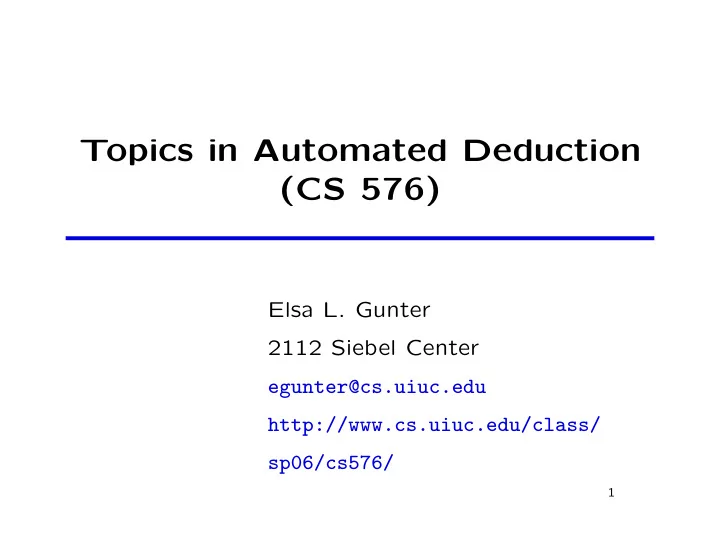

Topics in Automated Deduction (CS 576) Elsa L. Gunter 2112 Siebel Center egunter@cs.uiuc.edu http://www.cs.uiuc.edu/class/ sp06/cs576/ 1
Currying • Curried: f :: τ 1 ⇒ τ 2 ⇒ τ • Tupled: f :: τ 1 × τ 2 ⇒ τ Advantage: partial appliaction f a 1 with a 1 :: τ Moral: Thou shalt curry your functions (most of the time :-) ). 2
Terms: Syntactic Sugar Some predefined syntactic sugar: • Infix: +, − , #, @, . . . • Mixfix: if then else , case of , . . . • Binders: ∀ x . P x means ( ∀ )( λx. P x ) Prefix binds more strongly than infix: ! f x + y ≡ (f x) + y �≡ f (x + y) ! 3
Type bool Formulae = terms of type bool True::bool False::bool ¬ :: bool ⇒ bool ∧ , ∨ , . . . :: bool ⇒ bool . . . if-and-only-if: = 4
Type nat 0::nat Suc :: nat ⇒ nat +, *, . . . :: nat ⇒ nat ⇒ nat . . . 5
Overloading ! Numbers and arithmetic operations are overloaded: 0, 1, 2, . . . :: nat or real (or others) + :: nat ⇒ nat ⇒ nat and + :: real ⇒ real ⇒ real (and others) You need type annotations: 1 :: nat , x + ( y :: nat ) . . . unless the context is unambiguous: Suc 0 6
Type list • [ ]: empty list • x # xs: list with first element x (“head”) and rest xs (“tail”) • Syntactic sugar: [x 1 , . . . , x n ] ≡ x 1 # . . . #x n #[ ] Large library: hd, tl, map, size, filter, set, nth, take, drop, distinct, . . . Don’t reinvent, reuse! ❀ HOL/List.thy 7
Theory = Module Syntax: theory MyTh = ImpTh 1 + . . . + ImpTh n : (declarations, definitions, theorems, proofs, . . . ) end • MyTh : name of theory being built. Must live in file MyTh .thy . • ImpTh i : name of imported theories. Importing is transitive. 8
Proof General An Isabelle Interface by David Aspinall 9
ProofGeneral Customized version of (x)emacs: • All of emacs (info: Ctrl-h i ) • Isabelle aware when editing .thy files • (Optional) Can use mathematical symbols (“x-symbols”) Interaction: • via mouse / buttons / pull-down menus • or keybord (for key bindings, see Ctrl-h m ) 10
ProofGeneral Input Input of math symbols in ProofGeneral • via menu (“X-Symbol”) • via ascii encoding (similar to L A T X): E \ <and> , \ <or> , . . . • via “standard” ascii name: & , | , --> , . . . 11
Symbol Translations x-symbol ∀ ∃ ¬ ∧ λ ascii (1) \ <forall> \ <exists> \ <lambda> \ <not> \ <and> ascii (2) ∼ ALL EX % & x-symbol ∨ − → ⇒ ascii (1) \ <or> \ <longrightarrow> \ <Rightarrow> ascii (2) | --> => (1) is converted to x-xymbol, (2) remains as ascii See Appendix A of text for more complete list 12
Time for a demo of types and terms 13
A Recursive datatype datatype ’a list = Nil | Cons ’a "’a list" Nil: empty list Cons x xs: list with head x::’a, tail xs::’a list A toy list: Cons False (Cons True Nil) Syntactic sugar: [False, True] 14
Contrete Syntax When writing terms and types in .thy files (or an Is- abelle shell): Types and terms need to be enclosed in "..." Except for single identifiers, e.g. ’a " ..." won’t always be shown on slides 15
Structural Induction on Lists P xs holds for all lists xs if • P Nil • and for arbitrary y and ys , P ys implies P (Cons y ys) P ys . . . P (Cons y ys) P xs 16
A Recursive Function: List Append Declaration: "’a list ⇒ ’a list ⇒ ’a list consts app :: and definition by primitive recursion : primrec app Nil ys = app (Cons x xs) ys = app xs ... One rule per constructor Recursive calls only applied to constructor arguments Guarantees termination (total function) 17
Demo: Append and Reverse 18
Proofs General schema: lemma name : " ..." apply ( ...) . . . done If the lemma is suitable as a simplification rule: lemma name [simp]: " ..." Adds lemma name to future simplificaitons 19
Top-down Proofs sorry “completes” any proof (by giving up, and accepting it) Suitable for top-down development of theories: Assume lemmas first, prove them later. Only allowed for interactive proof! 20
Recommend
More recommend